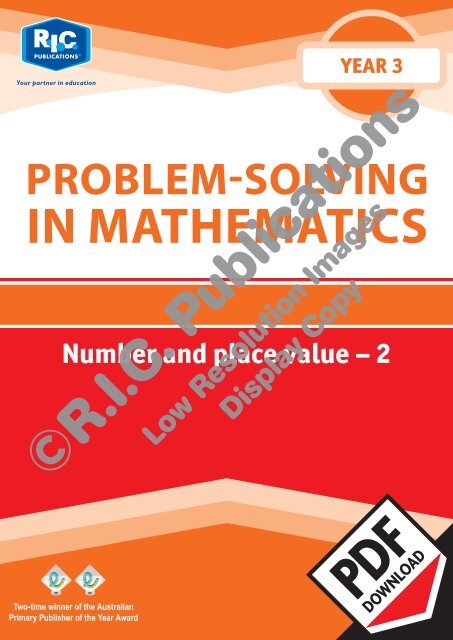20731_Problem_solving_Year_3_Number_and_Place_Value_2
Create successful ePaper yourself
Turn your PDF publications into a flip-book with our unique Google optimized e-Paper software.
Your partner in education<br />
YEAR 3<br />
PROBLEM-SOLVING<br />
IN MATHEMATICS<br />
<strong>Number</strong> <strong>and</strong> place value – 2<br />
Two-time winner of the Australian<br />
Primary Publisher of the <strong>Year</strong> Award
<strong>Problem</strong>-<strong>solving</strong> in mathematics<br />
(Book D)<br />
Published by R.I.C. Publications ® 2008<br />
Copyright © George Booker <strong>and</strong><br />
Denise Bond 2007<br />
RIC–<strong>20731</strong><br />
This master may only be reproduced by the<br />
original purchaser for use with their class(es). The<br />
publisher prohibits the loaning or onselling of this<br />
master for the purposes of reproduction.<br />
Copyright Notice<br />
Blackline masters or copy masters are published <strong>and</strong><br />
sold with a limited copyright. This copyright allows<br />
publishers to provide teachers <strong>and</strong> schools with a<br />
wide range of learning activities without copyright<br />
being breached. This limited copyright allows the<br />
purchaser to make sufficient copies for use within<br />
their own education institution. The copyright is not<br />
transferable, nor can it be onsold. Following these<br />
instructions is not essential but will ensure that you,<br />
as the purchaser, have evidence of legal ownership<br />
to the copyright if inspection occurs.<br />
For your added protection in the case of copyright<br />
inspection, please complete the form below. Retain<br />
this form, the complete original document <strong>and</strong> the<br />
invoice or receipt as proof of purchase.<br />
Name of Purchaser:<br />
Date of Purchase:<br />
Supplier:<br />
School Order# (if applicable):<br />
Signature of Purchaser:<br />
Internet websites<br />
In some cases, websites or specific URLs may be recommended. While these are checked <strong>and</strong> rechecked at the time of publication,<br />
the publisher has no control over any subsequent changes which may be made to webpages. It is strongly recommended that the class<br />
teacher checks all URLs before allowing students to access them.<br />
View all pages online<br />
PO Box 332 Greenwood Western Australia 6924<br />
Website: www.ricpublications.com.au<br />
Email: mail@ricgroup.com.au
FOREWORD<br />
Books A–G of <strong>Problem</strong>-<strong>solving</strong> in mathematics have been developed to provide a rich resource for teachers<br />
of students from the early years to the end of middle school <strong>and</strong> into secondary school. The series of problems,<br />
discussions of ways to underst<strong>and</strong> what is being asked <strong>and</strong> means of obtaining solutions have been built up to<br />
improve the problem-<strong>solving</strong> performance <strong>and</strong> persistence of all students. It is a fundamental belief of the authors<br />
that it is critical that students <strong>and</strong> teachers engage with a few complex problems over an extended period rather than<br />
spend a short time on many straightforward ‘problems’ or exercises. In particular, it is essential to allow students<br />
time to review <strong>and</strong> discuss what is required in the problem-<strong>solving</strong> process before moving to another <strong>and</strong> different<br />
problem. This book includes extensive ideas for extending problems <strong>and</strong> solution strategies to assist teachers in<br />
implementing this vital aspect of mathematics in their classrooms. Also, the problems have been constructed <strong>and</strong><br />
selected over many years’ experience with students at all levels of mathematical talent <strong>and</strong> persistence, as well as<br />
in discussions with teachers in classrooms, professional learning <strong>and</strong> university settings.<br />
<strong>Problem</strong>-<strong>solving</strong> does not come easily to most people,<br />
so learners need many experiences engaging with<br />
problems if they are to develop this crucial ability. As<br />
they grapple with problem, meaning <strong>and</strong> find solutions,<br />
students will learn a great deal about mathematics<br />
<strong>and</strong> mathematical reasoning; for instance, how to<br />
organise information to uncover meanings <strong>and</strong> allow<br />
connections among the various facets of a problem<br />
to become more apparent, leading to a focus on<br />
organising what needs to be done rather than simply<br />
looking to apply one or more strategies. In turn, this<br />
extended thinking will help students make informed<br />
choices about events that impact on their lives <strong>and</strong> to<br />
interpret <strong>and</strong> respond to the decisions made by others<br />
at school, in everyday life <strong>and</strong> in further study.<br />
Student <strong>and</strong> teacher pages<br />
The student pages present problems chosen with a<br />
particular problem-<strong>solving</strong> focus <strong>and</strong> draw on a range<br />
of mathematical underst<strong>and</strong>ings <strong>and</strong> processes.<br />
For each set of related problems, teacher notes <strong>and</strong><br />
discussion are provided, as well as indications of<br />
how particular problems can be examined <strong>and</strong> solved.<br />
Answers to the more straightforward problems <strong>and</strong><br />
detailed solutions to the more complex problems<br />
ensure appropriate explanations, the use of the<br />
pages, foster discussion among students <strong>and</strong> suggest<br />
ways in which problems can be extended. Related<br />
problems occur on one or more pages that extend the<br />
problem’s ideas, the solution processes <strong>and</strong> students’<br />
underst<strong>and</strong>ing of the range of ways to come to terms<br />
with what problems are asking.<br />
At the top of each teacher page, there is a statement<br />
that highlights the particular thinking that the<br />
problems will dem<strong>and</strong>, together with an indication<br />
of the mathematics that might be needed <strong>and</strong> a list<br />
of materials that could be used in seeking a solution.<br />
A particular focus for the page or set of three pages<br />
of problems then exp<strong>and</strong>s on these aspects. Each<br />
book is organised so that when a problem requires<br />
complicated strategic thinking, two or three problems<br />
occur on one page (supported by a teacher page with<br />
detailed discussion) to encourage students to find<br />
a solution together with a range of means that can<br />
be followed. More often, problems are grouped as a<br />
series of three interrelated pages where the level of<br />
complexity gradually increases, while the associated<br />
teacher page examines one or two of the problems in<br />
depth <strong>and</strong> highlights how the other problems might be<br />
solved in a similar manner.<br />
R.I.C. Publications ® www.ricpublications.com.au <strong>Problem</strong>-<strong>solving</strong> in mathematics<br />
iii
FOREWORD<br />
Each teacher page concludes with two further aspects<br />
critical to successful teaching of problem-<strong>solving</strong>. A<br />
section on likely difficulties points to reasoning <strong>and</strong><br />
content inadequacies that experience has shown may<br />
well impede students’ success. In this way, teachers<br />
can be on the look out for difficulties <strong>and</strong> be prepared<br />
to guide students past these potential pitfalls. The<br />
final section suggests extensions to the problems to<br />
enable teachers to provide several related experiences<br />
with problems of these kinds in order to build a rich<br />
array of experiences with particular solution methods;<br />
for example, the numbers, shapes or measurements<br />
in the original problems might change but leave the<br />
means to a solution essentially the same, or the<br />
context may change while the numbers, shapes or<br />
measurements remain the same. Then numbers,<br />
shapes or measurements <strong>and</strong> the context could be<br />
changed to see how the students h<strong>and</strong>le situations<br />
that appear different but are essentially the same<br />
as those already met <strong>and</strong> solved. Other suggestions<br />
ask students to make <strong>and</strong> pose their own problems,<br />
investigate <strong>and</strong> present background to the problems<br />
or topics to the class, or consider solutions at a more<br />
general level (possibly involving verbal descriptions<br />
<strong>and</strong> eventually pictorial or symbolic arguments).<br />
In this way, not only are students’ ways of thinking<br />
extended but the problems written on one page are<br />
used to produce several more problems that utilise<br />
the same approach.<br />
Mathematics <strong>and</strong> language<br />
The difficulty of the mathematics gradually increases<br />
over the series, largely in line with what is taught<br />
at the various year levels, although problem-<strong>solving</strong><br />
both challenges at the point of the mathematics<br />
that is being learned as well as provides insights<br />
<strong>and</strong> motivation for what might be learned next. For<br />
example, the computation required gradually builds<br />
from additive thinking, using addition <strong>and</strong> subtraction<br />
separately <strong>and</strong> together, to multiplicative thinking,<br />
where multiplication <strong>and</strong> division are connected<br />
conceptions. More complex interactions of these<br />
operations build up over the series as the operations<br />
are used to both come to terms with problems’<br />
meanings <strong>and</strong> to achieve solutions. Similarly, twodimensional<br />
geometry is used at first but extended<br />
to more complex uses over the range of problems,<br />
then joined by interaction with three-dimensional<br />
ideas. Measurement, including chance <strong>and</strong> data, also<br />
extends over the series from length to perimeter, <strong>and</strong><br />
from area to surface area <strong>and</strong> volume, drawing on<br />
the relationships among these concepts to organise<br />
solutions as well as giving an underst<strong>and</strong>ing of the<br />
metric system. Time concepts range from interpreting<br />
timetables using 12-hour <strong>and</strong> 24-hour clocks while<br />
investigations related to mass rely on both the concept<br />
itself <strong>and</strong> practical measurements.<br />
The language in which the problems are expressed is<br />
relatively straightforward, although this too increases<br />
in complexity <strong>and</strong> length of expression across the books<br />
in terms of both the context in which the problems<br />
are set <strong>and</strong> the mathematical content that is required.<br />
It will always be a challenge for some students<br />
to ‘unpack’ the meaning from a worded problem,<br />
particularly as problems’ context, information <strong>and</strong><br />
meanings exp<strong>and</strong>. This ability is fundamental to the<br />
nature of mathematical problem-<strong>solving</strong> <strong>and</strong> needs to<br />
be built up with time <strong>and</strong> experiences rather than be<br />
iv<br />
<strong>Problem</strong>-<strong>solving</strong> in mathematics www.ricpublications.com.au R.I.C. Publications ®
FOREWORD<br />
diminished or left out of the problems’ situations. One<br />
reason for the suggestion that students work in groups<br />
is to allow them to share <strong>and</strong> assist each other with<br />
the tasks of discerning meanings <strong>and</strong> ways to tackle<br />
the ideas in complex problems through discussion,<br />
rather than simply leaping into the first ideas that<br />
come to mind (leaving the full extent of the problem<br />
unrealised).<br />
An approach to <strong>solving</strong> problems<br />
Try<br />
an approach<br />
Explore<br />
means to a solution<br />
Analyse<br />
the problem<br />
The careful, gradual development of an ability to<br />
analyse problems for meaning, organising information<br />
to make it meaningful <strong>and</strong> to make the connections<br />
among them more meaningful in order to suggest<br />
a way forward to a solution is fundamental to the<br />
approach taken with this series, from the first book<br />
to the last. At first, materials are used explicitly to<br />
aid these meanings <strong>and</strong> connections; however, in<br />
time they give way to diagrams, tables <strong>and</strong> symbols<br />
as underst<strong>and</strong>ing <strong>and</strong> experience of <strong>solving</strong> complex,<br />
engaging problems increases. As the problem forms<br />
exp<strong>and</strong>, the range of methods to solve problems<br />
is carefully extended, not only to allow students to<br />
successfully solve the many types of problems, but<br />
also to give them a repertoire of solution processes<br />
that they can consider <strong>and</strong> draw on when new<br />
situations are encountered. In turn, this allows them<br />
to explore one or other of these approaches to see<br />
whether each might furnish a likely result. In this way,<br />
when they try a particular method to solve a new<br />
problem, experience <strong>and</strong> analysis of the particular<br />
situation assists them to develop a full solution.<br />
Not only is this model for the problem-<strong>solving</strong> process<br />
helpful in <strong>solving</strong> problems, it also provides a basis for<br />
students to discuss their progress <strong>and</strong> solutions <strong>and</strong><br />
determine whether or not they have fully answered<br />
a question. At the same time, it guides teacher<br />
questions of students <strong>and</strong> provides a means of seeing<br />
underlying mathematical difficulties <strong>and</strong> ways in<br />
which problems can be adapted to suit particular<br />
needs <strong>and</strong> extensions. Above all, it provides a common<br />
framework for discussions between a teacher <strong>and</strong><br />
group or whole class to focus on the problem-<strong>solving</strong><br />
process rather than simply on the solution of particular<br />
problems. Indeed, as Alan Schoenfeld, in Steen L (Ed)<br />
Mathematics <strong>and</strong> democracy (2001), states so well, in<br />
problem-<strong>solving</strong>:<br />
getting the answer is only the beginning rather than<br />
the end … an ability to communicate thinking is<br />
equally important.<br />
We wish all teachers <strong>and</strong> students who use these<br />
books success in fostering engagement with problem<strong>solving</strong><br />
<strong>and</strong> building a greater capacity to come to<br />
terms with <strong>and</strong> solve mathematical problems at all<br />
levels.<br />
George Booker <strong>and</strong> Denise Bond<br />
R.I.C. Publications ® www.ricpublications.com.au <strong>Problem</strong>-<strong>solving</strong> in mathematics<br />
v
CONTENTS<br />
Foreword .................................................................. iii – v<br />
Contents .......................................................................... vi<br />
Introduction ........................................................... vii – xix<br />
A note on calculator use ................................................ xx<br />
Teacher notes.................................................................... 2<br />
Stacking shapes................................................................ 3<br />
Painted cubes.................................................................... 4<br />
Cube painting.................................................................... 5<br />
Teacher notes.................................................................... 6<br />
How many digits?............................................................. 7<br />
Teacher notes.................................................................... 8<br />
Star gaze........................................................................... 9<br />
Magic squares/Famous magic squares.......................... 10<br />
Sudoku............................................................................ 11<br />
Teacher notes.................................................................. 12<br />
The water park................................................................ 13<br />
Lily pads <strong>and</strong> frogs.......................................................... 14<br />
Gone fishing.................................................................... 15<br />
Teacher notes.................................................................. 16<br />
Chicken takeaway........................................................... 17<br />
Teacher notes.................................................................. 18<br />
The big race.................................................................... 19<br />
Serial numbers............................................................... 20<br />
Puzzle scrolls................................................................... 21<br />
Teacher notes.................................................................. 22<br />
Samantha’s flower shop.................................................. 23<br />
Herb market.................................................................... 24<br />
At the bakery................................................................... 25<br />
Teacher notes.................................................................. 26<br />
<strong>Number</strong>s in columns....................................................... 27<br />
Teacher notes.................................................................. 28<br />
Calculator problems........................................................ 29<br />
Ice-cream cones.............................................................. 30<br />
Chocolate frogs............................................................... 31<br />
Teacher notes.................................................................. 32<br />
How many?..................................................................... 33<br />
How far?.......................................................................... 34<br />
How much?..................................................................... 35<br />
Teacher notes.................................................................. 36<br />
Tropical Cairns................................................................. 37<br />
Teacher notes ................................................................. 38<br />
Squares <strong>and</strong> perimeters.................................................. 39<br />
More perimeters............................................................. 40<br />
Perimeters in squares.................................................... 41<br />
Teacher notes.................................................................. 42<br />
Beading........................................................................... 43<br />
Library............................................................................. 44<br />
At the station.................................................................. 45<br />
Teacher notes.................................................................. 46<br />
Bookworms..................................................................... 47<br />
Teacher notes ................................................................. 48<br />
Farm trails ...................................................................... 49<br />
Balancing........................................................................ 50<br />
Squares <strong>and</strong> area............................................................ 51<br />
Teacher notes.................................................................. 52<br />
DVD rentals..................................................................... 53<br />
Drive time........................................................................ 54<br />
Clock watching................................................................ 55<br />
Teacher notes.................................................................. 56<br />
On the farm..................................................................... 57<br />
In the barn....................................................................... 58<br />
Market day...................................................................... 59<br />
Teacher notes.................................................................. 60<br />
Shopping......................................................................... 61<br />
Solutions ..................................................................62–66<br />
Isometric resource page .............................................. 67<br />
0–99 board resource page ............................................ 68<br />
4-digit number exp<strong>and</strong>er resource page (x 3) ............... 69<br />
10 mm x 10 mm grid resource page ............................. 70<br />
15 mm x 15 mm grid resource page ............................. 71<br />
Triangular grid resource page ...................................... 72<br />
vi<br />
<strong>Problem</strong>-<strong>solving</strong> in mathematics www.ricpublications.com.au R.I.C. Publications ®
TEACHER NOTES<br />
<strong>Problem</strong>-<strong>solving</strong> objective<br />
To analyse <strong>and</strong> use information in word problems.<br />
Materials<br />
place value chart or a calculator<br />
Focus<br />
These pages explore word problems that mostly require<br />
addition or subtraction. Students need to determine what<br />
the problem is asking <strong>and</strong>, in many cases, calculate more<br />
than one step in order to find solutions. Analysis of the<br />
problems reveals that some questions contain additional<br />
information that is not needed.<br />
If necessary, materials can be used to assist with the<br />
calculation as these problems are about reading for<br />
information <strong>and</strong> determining what the problem is asking<br />
rather than computation or basic facts.<br />
Discussion<br />
Page 13<br />
These problems involve more than one step <strong>and</strong> may<br />
involve addition as well as subtraction. The wording<br />
has been kept simple to assist with the problem-<strong>solving</strong><br />
process.<br />
Students may choose a number of different ways to find<br />
a solution. For example, the second problem about people<br />
getting out (43) could be subtracted from the people going<br />
swimming (79) <strong>and</strong> then this number (36) could be added<br />
to 397 or, alternatively, 79 could be added to 397 <strong>and</strong> then<br />
43 subtracted to obtain a solution. Students should be<br />
encouraged to explore <strong>and</strong> try different ways of arriving<br />
at a solution.<br />
Page 15<br />
A careful reading of each problem is needed to determine<br />
what the question is asking. In some cases, there is more<br />
information than needed <strong>and</strong> some problems contain<br />
numbers that are not needed to find a solution. Most<br />
problems require more than one step <strong>and</strong> both addition<br />
<strong>and</strong> subtraction are needed at times.<br />
Again, there are a number of ways to find a solution<br />
<strong>and</strong> students should be encouraged to explore <strong>and</strong> try<br />
different possibilities of arriving at an answer. The last<br />
question involves students underst<strong>and</strong>ing that perch <strong>and</strong><br />
carp are varieties of fish, while yabbies are crustaceans.<br />
Possible difficulties<br />
• Inability to identify the need to add, subtract or<br />
multiply<br />
• Confusion over the need to carry out more than one<br />
step to arrive at a solution<br />
• Using all the numbers listed in the problems rather<br />
than just the numbers needed<br />
Extension<br />
• Explore the possibilities as to whether the dry season<br />
would be before or after spring.<br />
• Discuss how some problems can have more than one<br />
answer depending on different interpretations.<br />
• Students could write their own problems <strong>and</strong> give<br />
them to others to solve.<br />
Page 14<br />
This investigation relates to information about a lake with<br />
lily pads <strong>and</strong> frogs. The scenario begins with a certain<br />
number of frogs <strong>and</strong> lily pads. As new information is<br />
introduced, the numbers change to meet the new criteria;<br />
lily pads flower, grow <strong>and</strong> die while the frogs move from<br />
one lake to another.<br />
Students are required to keep track of the new information<br />
<strong>and</strong> use it to answer the subsequent questions. The<br />
last question has two possible answers as it depends<br />
on whether spring is before or after the dry season.<br />
Students should be encouraged to explore the different<br />
possibilities.<br />
12<br />
<strong>Problem</strong>-<strong>solving</strong> in mathematics www.ricpublications.com.au R.I.C. Publications ®
THE WATER PARK<br />
1. 361 adults <strong>and</strong> 173 children go<br />
through the gates before lunch,<br />
<strong>and</strong> 219 adults <strong>and</strong> 106 children<br />
enter after lunch. How many<br />
more adults than children are<br />
there?<br />
2. A total of 397 people are<br />
swimming in the six pools.<br />
Another 79 people go swimming<br />
while 43 people get out. How<br />
many people are now swimming<br />
in the pools?<br />
3. 248 people are lying on their<br />
towels. Later, 78 people go<br />
swimming, 26 people go for a<br />
walk <strong>and</strong> 36 people leave <strong>and</strong><br />
get something to eat. How many<br />
people are still lying on their<br />
towels?<br />
4. In the water, 93 people are floating<br />
on swimming mats, 134 are<br />
swimming <strong>and</strong> 83 are wading in<br />
the shallow water. Soon, another<br />
21 people with swimming mats<br />
arrive, but 14 also get out. How<br />
many people are now floating on<br />
swimming mats?<br />
5. At the cafeteria, 143 people are<br />
sitting eating lunch <strong>and</strong> 31 are<br />
st<strong>and</strong>ing in line waiting to order<br />
lunch. Two large tables of 12 finish<br />
their lunch <strong>and</strong> leave. How many<br />
people are now in the cafeteria?<br />
6. In the wave pool, 73 surfers are<br />
waiting to catch a wave. A large<br />
wave comes <strong>and</strong> 36 surfers catch<br />
<strong>and</strong> ride it to the beach. How<br />
many did not catch the wave?<br />
R.I.C. Publications ® www.ricpublications.com.au <strong>Problem</strong>-<strong>solving</strong> in mathematics<br />
13
LILY PADS AND FROGS<br />
A lake has 279 lily pads <strong>and</strong> 372 frogs.<br />
1. 87 of the lily pads are in flower. If each lily pad has three flowers, how<br />
many flowers are there altogether?<br />
2. How many lily pads are not in flower?<br />
3. Frogs like to sleep under the lily flowers. How many frogs can not sleep<br />
under a flower?<br />
4. When the rains come, 38 more lily pads burst into flower. How many lily<br />
pads are now in flower?<br />
5. Are there now enough lily flowers for each frog to sleep under?<br />
6. During spring, 129 new lily pads grow, 186 tadpoles turn into frogs <strong>and</strong><br />
75 lily pads die. How many lily pads are now in the lake?<br />
7. During the dry season, some frogs move to another lake. If 148 frogs<br />
move to another lake, how many stay behind?<br />
14<br />
<strong>Problem</strong>-<strong>solving</strong> in mathematics www.ricpublications.com.au R.I.C. Publications ®
GONE FISHING<br />
1. On Saturday, 97 large yabbies, 21 small yabbies <strong>and</strong> 57 carp were<br />
caught. On Sunday, 126 large yabbies, 34 small yabbies <strong>and</strong> 83 carp<br />
were caught. How many yabbies were caught?<br />
2. During the week, 163 perch, 394 carp <strong>and</strong> 304 bass were caught in the<br />
dam. How much more bass than perch was caught?<br />
3. During a fishing competition, 923 perch were caught, tagged <strong>and</strong> then<br />
released back into the dam. 359 tagged perch were caught in October,<br />
271 in November <strong>and</strong> 106 in December. How many tagged perch have<br />
not been caught?<br />
During the first weekend in June, 239 perch, 56 large yabbies, 17 small<br />
yabbies <strong>and</strong> 43 carp were caught. The next weekend, 161 perch, 79 large<br />
yabbies, 24 small yabbies <strong>and</strong> 65 carp were caught.<br />
4. During which weekend were the most yabbies caught?<br />
5. During which weekend were the least amount of fish <strong>and</strong> yabbies<br />
caught?<br />
6. During which weekend were the most fish caught?<br />
R.I.C. Publications ® www.ricpublications.com.au <strong>Problem</strong>-<strong>solving</strong> in mathematics<br />
15
SOLUTIONS<br />
Note: Many solutions are written statements rather than just numbers. This is to encourage teachers <strong>and</strong> students to solve<br />
problems in this way.<br />
THE WATER PARK..............................................Page 13<br />
1. 301 more adults<br />
2. 433 people swimming in the pools<br />
3. 108 people lying on their towels<br />
4. 100 people floating on swimming mats<br />
5. 150 people<br />
6. 37 surfers did not catch a wave.<br />
LILY PADS AND FROGS ....................................Page 14<br />
1. 261 flowers<br />
2. 192 lily pads<br />
3. 111 frogs<br />
4. 125 lily pads are in flower<br />
5. Yes, there are 375 flowers<br />
6. 333 lily pads<br />
7. If the dry season is before spring, 224 frogs stayed<br />
behind. If the dry season is after spring, 410 frogs stayed<br />
behind.<br />
GONE FISHING ..................................................Page 15<br />
1. 278 yabbies were caught.<br />
2. 141 more bass were caught.<br />
3. 187 perch have not been caught.<br />
4. Second weekend<br />
5. First weekend<br />
6. First weekend: 282 fish were caught—yabbies are not<br />
fish.<br />
R.I.C. Publications ® www.ricpublications.com.au <strong>Problem</strong>-<strong>solving</strong> in mathematics<br />
63


















